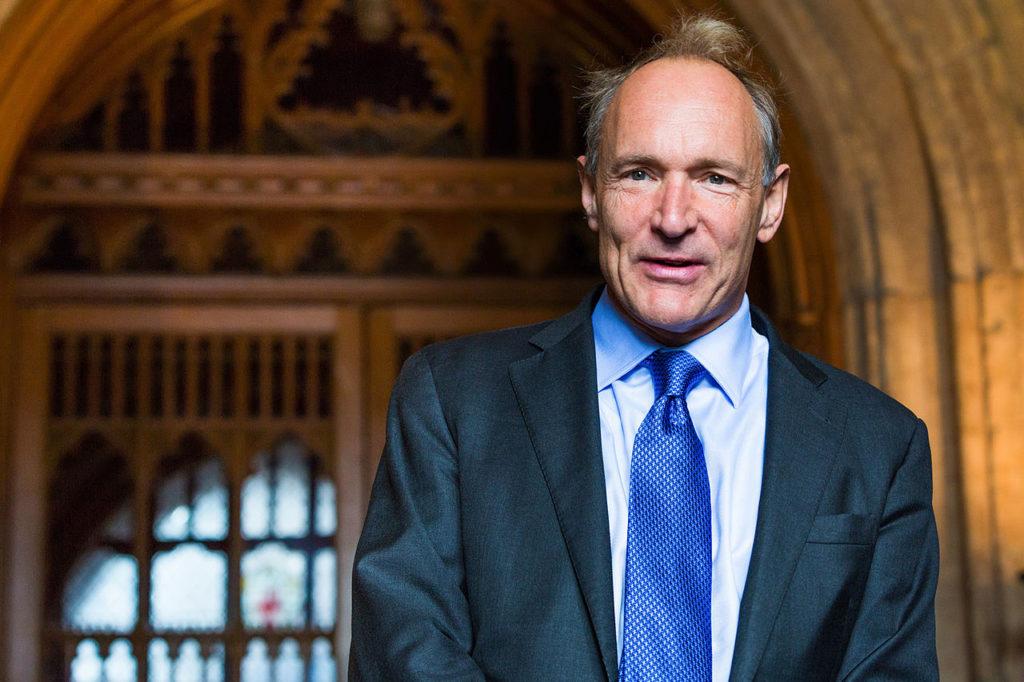Heroes of Technology: Sir Tim Berners-Lee
by Scott Dutfield · 12/03/2019

The revolutionary computer scientist who invented the World Wide Web
Born in June 1955 in London, Sir Timothy Berners-Lee’s pioneering work has transformed every aspect of our lives; he is the creator of one of the greatest inventions of the 20th century. Berners-Lee was not the first in his family to master mathematics; his parents Conway Berners-Lee and Mary Lee Woods also dedicated their lives to the subject. His passion for science led him to attend Oxford University, where in 1976 he graduated with a first-class degree in physics.
After completing his degree, Berners-Lee moved on to become a scientist at CERN, the European Organization for Nuclear Research, in 1989. That same year, Berners-Lee published a paper titled Information Management: A Proposal, in which he suggested the combination of hypertext and the internet for an information management system. In this initial proposal for the World Wide Web, Berners-Lee described the shortcomings of the then-current system at CERN in allowing scientists access to their information and documentation. Though the internet had been around for a decade, the information had limited accessibility. Berners-Lee set out to connect both the internet and a web-structured platform to revolutionise data sharing. To achieve this he created the Hypertext Transfer Protocol (HTTP), Uniform Resource Identifier (URI) and Hypertext Makeup Language (HTML), the building blocks for internet browsing that remain in use today. Created to better serve CERN scientists and assist those across the globe with their research, Berners-Lee launched the first website, http://info.cern.ch, in 1990.
This new way to obtain information was something Berners-Lee wanted the entire world to have access to. He decided to make the World Wide Web an open and royalty-free software, allowing it to grow beyond academia. By 1994 there were around 3,000 websites in existence: today there are over 1 billion. After such a roaring success, Berners-Lee created W3C (World Wide Web Consortium), a web standards organisation that also develops web specifications, guidelines, software and tools. With the continued success of the iconic ‘www.’, Berners-Lee founded the World Wide Web Foundation in 2009, an organisation working to deliver digital equality to the world. Berners-Lee has been honoured with multiple awards over the years, including the prestigious ACM AM Turing Award (referred to as the ‘Nobel Prize of computing’). In 1997, he was appointed an Officer of the Order of the British Empire (OBE), then in 2004 he was promoted to Knight Commander (KBE) “for services to the global development of the internet”. Following decades of scientific and economic success, Berners-Lee has now returned to his Oxford University roots. Joining the staff as a Professor of Computer Science, Berners-Lee is inspiring the next generation of digital creators.
Weaving the World Wide Web

The concept of the World Wide Web is relatively simple: it works to provide the user with information from a variety of sources in a non-linear fashion, hence a ‘web’. The construction, however, is not so simple. Sir Tim Berners-Lee used something called hypertext to achieve this. By allowing text to hold more text and other information within it, users can jump from one place to another. It works in a similar way to how a hyperlink would work on a text document but in a continuous fashion. Combined with the global capacity of the internet, hypertext is placed within browser platforms and held on different servers to enable global connectivity.
A life’s work
The road to an invention that truly changed the world
- 1995: Berners-Lee is born on 8 June in London to parents Conway Berners-Lee and Mary Lee Woods.
- 1975: He graduates from the University of Oxford, achieving a first-class degree in physics.
- 1989: 1989 While working at CERN, Berners-Lee invents the World Wide Web.
- 1990: The first web client and server is written by Berners-Lee.
- 1994: He becomes the director of the World Wide Web Consortium, developing interoperable technologies.
- 1999: Publishes his book Weaving the Web, which describes the development of the World Wide Web and his role in it.
- 2004: Knighted by Queen Elizabeth II for services to the global development of the internet.
- 2009: Berners-Lee is elected the foreign associate of the National Academy of Science.
- 2013: Awarded the Queen Elizabeth Prize for Engineering for “groundbreaking innovation in engineering that has been of global benefit to humanity.”
- 2016: Berners-Lee wins the ACM AM Turing Award for the invention of the World Wide Web.
Top 5 Facts
1. He has more than one doctorate: Berners-Lee has been bestowed with honorary degrees and doctorates from institutions around the world, such as the prestigious universities of Harvard and Yale.
2. He’s in the hall of fame: The Internet Hall of Fame to be exact, launched by the Internet Society in 2012 to celebrate the living history of the internet and its many extraordinary contributors.
3. He was in the Olympics: You may have spotted Sir Tim in the opening ceremony of the 2012 Olympic Games in London, sat with the computer he originally used when developing the Web.
4. His parents were pioneers too: As mathematicians, his parents Conway Berners-Lee and Mary Lee Woods worked on the world’s first commercially built computer, the Ferranti Mark 1.
5. The Web wasn’t his first creation: Called ENQUIRE, in 1980 Berners-Lee designed a computer system to find and share information.
This article was originally published in How It Works issue 108
For more science and technology articles, pick up the latest copy of How It Works from all good retailers or from our website now. If you have a tablet or smartphone, you can also download the digital version onto your iOS or Android device. To make sure you never miss an issue of How It Works magazine, subscribe today!





